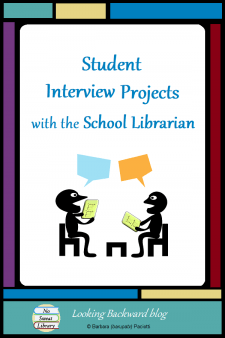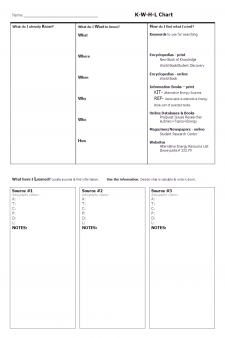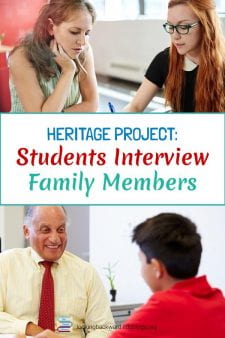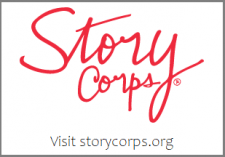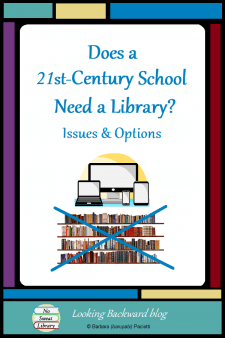 The controversy about whether high-tech schools need a library continues to be a hot educational debate. If LM_NET posts are any indication, that debate, along with arguments about size, configuration, furniture, and collections are ongoing. This becomes a critical issue when planning a new—or renovated—school. To my mind, the primary consideration, whether elementary, middle, or high school is this:
The controversy about whether high-tech schools need a library continues to be a hot educational debate. If LM_NET posts are any indication, that debate, along with arguments about size, configuration, furniture, and collections are ongoing. This becomes a critical issue when planning a new—or renovated—school. To my mind, the primary consideration, whether elementary, middle, or high school is this:
What will best serve the students and curriculum in this school?
Reflecting on my years as the ‘surrogate’ librarian teaching in an at-risk alternative high school through my years as a certified Middle School Librarian, I’ve had my share of quandaries about what a school needs for a library. I’m not alone, so here are some of the issues and options I and others have encountered.
OPTION: SCHOOL AS LIBRARY
My first issue was in the alternative school: we had several-hundred books in a very small, never-used “library” room which were never used—in fact, most of the teachers didn’t even realize we had them! As a solution I wanted to disperse books to relevant classrooms where students & teachers could use them directly.
The library director was concerned about how we’d keep track of where books were and how we’d check them out. I responded that our alternative students never take school materials home, so would only use books in the classrooms. The district library automation system had a secondary field for location—the first being school name—and I could add the classroom number and teacher name where each book was located.
I was granted permission to implement my plan. Teachers and students were thrilled, and the books were used constantly. We called it “School As Library.” Alas, two years after I left to become a middle school librarian, the library director had all the books put back in the “library” room—to the chagrin of faculty and kids—and books once again faded into oblivion. About 10 years later I heard the “library” had been moved to a larger room with an updated collection, but when I visited the school, it languished in obscurity just as the prior one had.
My takeaway from this is, regardless of the library, there must be a “librarian”—real or surrogate—to care for the library collection and advocate its use to teachers & students.
OPTION: MOBILE SATELLITE LIBRARIES
 Interestingly, it seems School as Library may become the next “hot” topic. In a recent LM_NET discussion, an elementary School Librarian, on a committee to plan for new and renovated libraries, wrote:
Interestingly, it seems School as Library may become the next “hot” topic. In a recent LM_NET discussion, an elementary School Librarian, on a committee to plan for new and renovated libraries, wrote:
We are being told that the future of libraries is to reduce the space of the actual library and have books in mini satellite stations around the school. We are also being told that book cases should all be on wheels so the collection is more portable.
She asked for input, and among the responses here are the most relevant issues:
- Satellite stations of books cut off full access to students. The library of the future is the Learning Commons which doesn’t involve reducing library space or moving books outside of the library.
- Mobile book shelves are great to create spaces within the library for different uses, but for an entire school, mobile tables and chairs would better serve as collaborative mini satellite stations.
I related my positive experience at the alternative school and suggested two solutions:
- Put the satellite libraries into classrooms where they could be monitored by teachers, placing mostly curricular-related materials in their bookcases.
- Devise a quick, perhaps technological, way for students to check out books to track who had them.
ISSUE: LIBRARY BLUNDERS BY THE UNINFORMED
The above LM_NET post also prompted librarians to reveal design problems with new or proposed libraries. Non-library professionals don’t understand what the school library…and the School Librarian…does, and here are some of the problems:
- A brand new building wasn’t given enough bookshelves, so they have to use portable round wire racks.
- In a new high school building the shelves are too short. There are huge display cabinets, but shelves for books would have been much more useful.
- Architects, unaware that library shelving comes in three-foot-wide sections, ignored the need for certain linear feet of shelving. They also drew less furniture “so it looks open and spacious,” ignoring the need to accommodate normal class sizes in group seating areas.
- An architect couldn’t grasp that a section of the checkout counter needed to be lower for patrons in wheelchairs.
- Electrical outlets were mounted at floor level instead of high enough to be used by charging stations.
Barbara Braxton, a retired School Librarian in Australia (one of my gurus) had this to say:
Certainly the concept of libraries as having more flexible spaces is a driving force in design and the tale of architects not consulting those who use them is common. Don’t assume that administrators, let alone architects, have any idea about best practice in 21st century libraries—we are the experts and we need to tell them. (edited for brevity)
The consensus is to campaign for an architect/designer who has experience designing libraries:
- Identify the essentials and why, particularly for work safety, work flow, and user access;
- measure and create a floor plan; and
- keep standing your ground—it pays off in the end.
ISSUE: TROUBLESOME BOOKCASE HEIGHTS
I am bewildered by elementary libraries with 7-foot high shelving. I’ve suggested to elementary librarians complaining about lack of shelf space, to scatter professional teacher & classroom materials on the top shelves above their associated Dewey numbers of the student books (to have topical materials together). This opens up the lower shelves of those bookcases for the itty-bitties’ books.
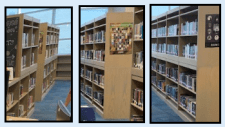
One HS’s solution: short bookcases stacked & bolted together.
I am likewise puzzled by a high school library with 3-foot high shelving. While some high school librarians love their shorter mobile shelves (which are extremely heavy when loaded with books), for those who don’t I suggest they remove wheels from some of the bookcases and stack one atop another in a permanent location, attaching bolts or flat brackets to secure them together.
I have plenty of 5-foot high bookcases in my middle school library and it’s the perfect height for these students. I don’t need to use the bottom shelf for books, so I added leftover slanted shelves to display new arrivals or thematic reads. This draws attention down so students also “see” books on the shelf below waist height.
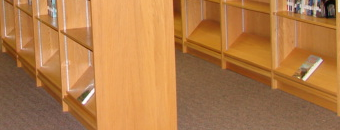
Slanted bottom shelves display new arrivals…which disappear fast!
The 5-foot height is ideal for displaying classroom projects and other interesting artifacts during the school year. The cases are low enough to allow easy viewing, but high enough to discourage students from handling the displays.
My 5′ high bookcases are also a convenient place to store items returned from classrooms for summer break so I don’t need extra storage space in the library that sits empty during the school year. It’s easy to put stuff up there and to pull down and send back to classrooms when school begins. I have a bin for each classroom with the room number and teacher name on it so it’s also easy to organize.
ISSUE: PHYSICAL PRINT VS. DIGITAL ONLINE
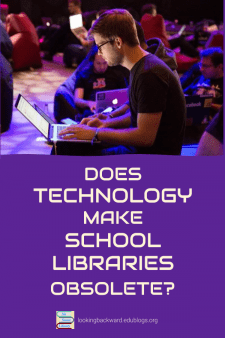 My first stumbling block as a middle school librarian was about purchasing online subscription reference databases. Our 2-yr-old middle school was a prototype high-tech school with a 1-to-3 computer-to-student ratio. The small print collection couldn’t meet student research needs and online access should have been a given, but because we didn’t have the state-recommended books-per-student ratio, I was told I could purchase only print books with district library funds. Fortunately my principal had helped design the school as a model of technology and saw the absurdity of using old-school library standards for a modern, high-tech school. He provided the funds for me to purchase online services that would support our curriculum.
My first stumbling block as a middle school librarian was about purchasing online subscription reference databases. Our 2-yr-old middle school was a prototype high-tech school with a 1-to-3 computer-to-student ratio. The small print collection couldn’t meet student research needs and online access should have been a given, but because we didn’t have the state-recommended books-per-student ratio, I was told I could purchase only print books with district library funds. Fortunately my principal had helped design the school as a model of technology and saw the absurdity of using old-school library standards for a modern, high-tech school. He provided the funds for me to purchase online services that would support our curriculum.
As an avid Star Trekker, I don’t remember a print reference resource on any TV shows or movies. There were incidents where books were read, but for reference they always used COMPUTER. In the original series “Court Martial” episode, the law books Cogley piled up in Kirk’s quarters seemed to glorify books over computers, but it was the dilution & homogenization of information put on the computer that was criticized—much as we lament the poor quality of information on the Internet. And at the end of that episode, it’s the skillful use of the computer as a reference resource—not Cogley’s books—that finds the real culprit. (I wonder: if Lexis-Nexis had been digitized in the 60s, would Spock have convinced Cogley that it was far easier to search L-N than to wade through his hundreds of books?)
For years the “What will they do when they get to college?” argument tried to justify print reference, but colleges and universities have been online-resource rich since the 90s. As the number and variety of online subscription services has multiplied, the claim that “It’s faster to find information in a good reference book than on the Internet” is invalid.
Most School Librarians have drastically reduced print reference materials in favor of online subscription services. We still tell students that ‘not everything is on the Internet’, but as a reason for using our high-quality online resources. students now need to be more proficient at choosing and using online reference services than print reference sources.
The struggle now is getting teachers to assign online subscription resources and topical e-books instead of print. A corporate boss isn’t likely to say, “Joe, we need you to compile some information for the annual report, and we want you to use an encyclopedia, a book, and a newspaper, but only one website.” Yet teachers persist in giving these kinds of directions for assignments…or in the supreme case of laxity, just let students search for and submit information from any site on the Internet.
What about Fiction & Leisure Reading?
As students move from elementary to middle school to high school, leisure reading declines due to increased academic demands. Print is still preferred for elementary, but the print Fiction section of a high-tech secondary school library might smaller than prior standards. Purchasing lower-cost paperbacks can keep it current and inviting for students who say they prefer “a real book.” Using E-readers, tablets, or smartphones for reading is now popular for many secondary schools, and though that tired old refrain of the difficulty of ‘curling up with a computer’ persists, I actually prefer doing my leisure reading on my device, as do many of my students!
TO HAVE OR NOT HAVE … A SCHOOL LIBRARY
 In a podcast many years ago, David Warlick said students need a place to go in order to find, synthesize, and produce information, and the School Library is the logical place for an Information Production Center. He admonishes that students must have the opportunity to develop as effective communicators in print, video, audio, and digital formats, or their “voices” will simply not be heard. Now THAT is a powerful argument for having a School Library—to have no such place in a school would be irresponsible.
In a podcast many years ago, David Warlick said students need a place to go in order to find, synthesize, and produce information, and the School Library is the logical place for an Information Production Center. He admonishes that students must have the opportunity to develop as effective communicators in print, video, audio, and digital formats, or their “voices” will simply not be heard. Now THAT is a powerful argument for having a School Library—to have no such place in a school would be irresponsible.
I continue to believe that curriculum needs and student demographics ought to determine a School Library’s resources. We need to make strong assertions about providing students with information from a variety of high-quality resources, about teaching Information Literacy Skills for any kind of assignment, and about the one person in the school who can bring curriculum, technology, and communication together: a certified Teacher-Librarian.



